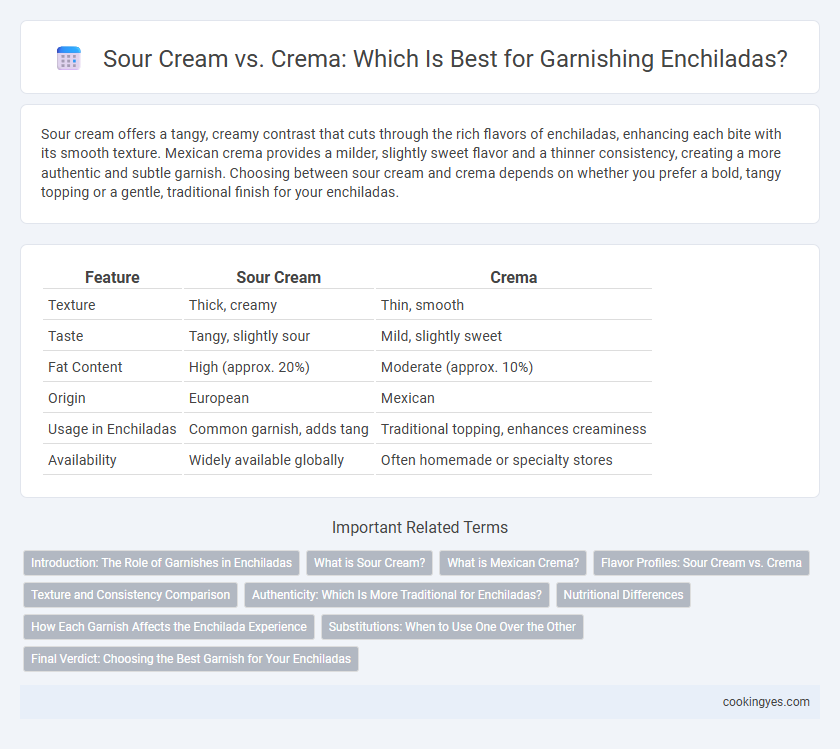Sour cream offers a tangy, creamy contrast that cuts through the rich flavors of enchiladas, enhancing each bite with its smooth texture. Mexican crema provides a milder, slightly sweet flavor and a thinner consistency, creating a more authentic and subtle garnish. Choosing between sour cream and crema depends on whether you prefer a bold, tangy topping or a gentle, traditional finish for your enchiladas.
Table of Comparison
| Feature | Sour Cream | Crema |
|---|---|---|
| Texture | Thick, creamy | Thin, smooth |
| Taste | Tangy, slightly sour | Mild, slightly sweet |
| Fat Content | High (approx. 20%) | Moderate (approx. 10%) |
| Origin | European | Mexican |
| Usage in Enchiladas | Common garnish, adds tang | Traditional topping, enhances creaminess |
| Availability | Widely available globally | Often homemade or specialty stores |
Introduction: The Role of Garnishes in Enchiladas
Sour cream and crema both play essential roles in enhancing the flavor and texture of enchiladas, offering creamy contrasts to the dish's spicy components. Sour cream provides a thick, tangy finish that balances heat, while crema delivers a smoother, slightly thinner consistency with a more subtle, rich taste. Choosing between sour cream and crema as a garnish directly influences the overall authenticity and sensory experience of traditional Mexican enchiladas.
What is Sour Cream?
Sour cream is a cultured dairy product made by fermenting regular cream with lactic acid bacteria, resulting in a tangy flavor and thick texture perfect for enchilada garnish. It typically contains around 20% fat, providing a creamy richness that balances the spicy and savory elements of enchiladas. Sour cream's acidity enhances the overall taste profile, making it a popular topping in Mexican cuisine.
What is Mexican Crema?
Mexican crema is a smooth, tangy dairy topping with a thinner consistency than sour cream, commonly used to garnish enchiladas for a rich and authentic flavor. Unlike sour cream, crema has a slightly sweeter and less acidic taste due to its higher fat content and mild fermentation process. Its creamy texture enhances the enchilada's sauce while adding a subtle depth that complements traditional Mexican spices.
Flavor Profiles: Sour Cream vs. Crema
Sour cream offers a tangy, slightly acidic flavor with a thick and creamy texture that balances the spiciness of enchiladas, enhancing their rich, savory notes. Crema, a Mexican staple, provides a milder, subtly sweet, and less tangy taste with a smooth, pourable consistency, lending a delicate creaminess without overpowering the dish. Choosing between sour cream and crema depends on whether you prefer a bold, zesty contrast or a gentle, creamy complement to your enchilada garnish.
Texture and Consistency Comparison
Sour cream offers a thick, creamy texture with a slightly tangy flavor that complements enchiladas by adding a rich consistency without overpowering the dish. Crema, a Mexican dairy product, is thinner and silkier than sour cream, providing a smooth, velvety finish that blends seamlessly into enchilada sauces. The choice between sour cream and crema for garnishing enchiladas depends on the desired mouthfeel, with sour cream delivering a firmer, creamier bite and crema yielding a lighter, more fluid consistency.
Authenticity: Which Is More Traditional for Enchiladas?
Traditional enchiladas are more authentically garnished with Mexican crema, a slightly thinner, tangier dairy product that enhances the dish's rich, spicy flavors without overpowering them. Sour cream, while popular in many American adaptations, lacks the subtle acidity and smooth texture that crema provides, making it less traditional in authentic Mexican cuisine. Using crema preserves the authentic taste and regional character of enchiladas, maintaining the dish's culinary heritage.
Nutritional Differences
Sour cream contains higher fat content, typically around 20%, which provides a rich, creamy texture but also increases calorie intake compared to crema. Crema, a Mexican dairy product similar to sour cream, has a lower fat percentage, usually between 10-15%, making it a lighter option with fewer calories while maintaining a smooth consistency. Both garnishes add tangy flavor to enchiladas, but choosing crema can enhance nutritional balance by reducing saturated fat consumption.
How Each Garnish Affects the Enchilada Experience
Sour cream adds a tangy richness and creaminess that balances the spicy and savory flavors of enchiladas, enhancing the overall mouthfeel with a cool contrast. Mexican crema offers a smoother, slightly thinner texture with a subtle sweetness, providing a delicate finish that melds seamlessly with the sauce and cheese. Choosing between sour cream and crema alters the enchilada's flavor profile and texture, influencing whether the dish feels more robust or delicately refined.
Substitutions: When to Use One Over the Other
Sour cream offers a tangy and thicker texture ideal for adding richness to enchiladas, while crema provides a milder, slightly sweet flavor with a thinner consistency that enhances dishes without overpowering other ingredients. Use sour cream when seeking a pronounced creamy contrast to spicy enchiladas, whereas crema works better for a smoother, more authentic Mexican garnish that blends seamlessly. Substitutions depend on flavor intensity and texture preferences, with sour cream suitable for a bold finish and crema preferred for a subtle, traditional touch.
Final Verdict: Choosing the Best Garnish for Your Enchiladas
Sour cream offers a tangy, creamy texture that balances the spiciness of enchiladas, while Mexican crema provides a richer, slightly sweeter flavor with a thinner consistency. For authentic flavor and smooth finish, crema is preferred in traditional Mexican cuisine, enhancing the dish without overpowering it. Choose sour cream for a bold contrast or crema for a delicate complement, depending on your taste and desired authenticity.
Sour cream vs Crema for Enchilada garnish Infographic

 cookingyes.com
cookingyes.com